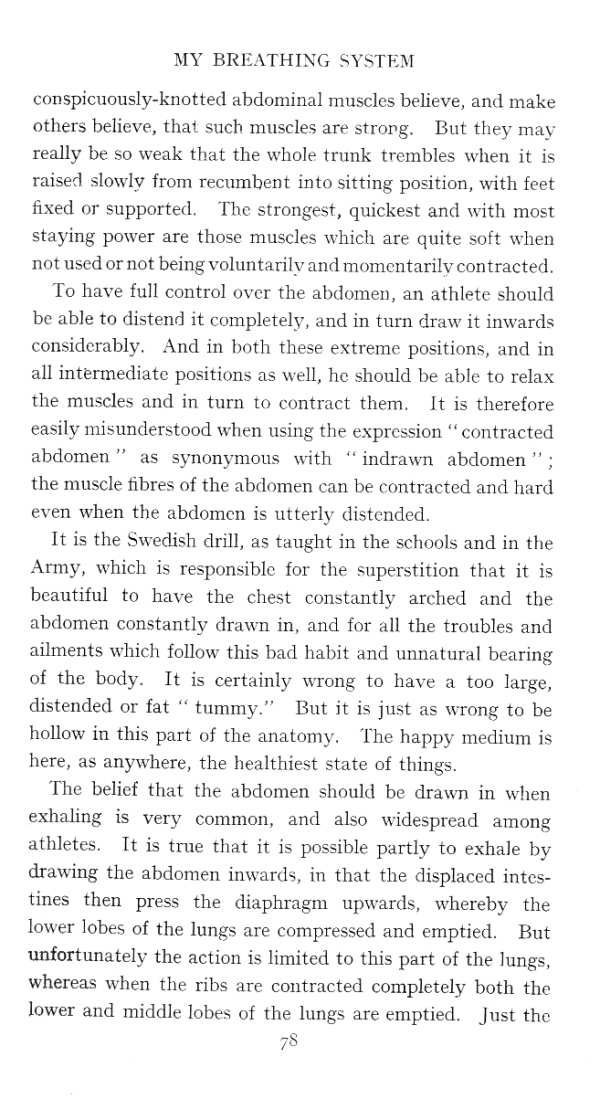mbs 078

MY BREATHING SYSTEM
conspicuously-knotted abdominal muscles believe, and make otliers believe, that sucb muscles are strorg. But they may really be so weak that the whole trunk trembles when it is raised slowly from recumbent into sitting position, with feet ftxed or supported. The strongest, ąuickest and with most staying power are those muscles whicli are quite soft wlien not used or not being voluntarily and momcntarily contracted.
To have fuli control over the abdomen, an athlete should be able to distend it completely, and in tum draw it inwards considerably. And in both these extreme positions, and in all intfcrmediatc positions as well, hc should be able to relax the muscles and in tum to contract them. It is therefore easily misunderstood when using the exprcssion “ contracted abdomen ” as synonymous with “ indrawn abdomen " ; the muscle libres of the abdomen can be contracted and hard even when the abdomen is utterly distended.
It is the Swedish drill, as taught in the schools and in the Anny, whicli is responsiblc for the superstition that it is beautiful to have the chest constantly arched and the abdomen constantly drawn in, and for all the troubles and ailments whicli follow tliis bad habit and unnatural bearing of the body. It is certainly wrong to have a too large, distended or fat “ tummy.” But it is just as wrong to be hollow in this part of the anatomy. The happy medium is here, as anywhere, the healthiest State of things.
The belief that the abdomen should be drawn in when exhaling is very common, and also widespread among athletes. It is tnie that it is possible partly to exhale by drawing the abdomen inwards, in that the displaced intes-tines then press the diaphragm upwards, whereby the lower lobes of the lungs are compressed and emptied. But unfortunately the action is limited to this part of the lungs, whereas when the ribs are contracted completely both the lower and middle lobes of the lungs are emptied. Just the
7«
Wyszukiwarka
Podobne podstrony:
mbs 042 MY BREATHING SYSTEM the liarm done by such old habits that special excrcise of “ abdominal&q
mbs 062 MY BREATHING SYSTEM inhalation, as a part of " my complete breath,” no attention should
70195 mbs 102 MY BREATHING SYSTEM EXERCISE No. 9. Special abdominal breathing, combined with movemen
mbs 005 MY BREATHING SYSTEM BYLIEUT. J. P. MI LLER, K.D. Author of My System," " My System
mbs 011 MY BREATHING SYSTEM and violent palpitatiops. Sncli an overstrained licart could never last
mbs 014 MY BREATHING SYSTEM slow, regular respiration, even during the hardcst and most protracted e
mbs 022 MY BREATHING SYSTEM against the invasion and throw ol f thc gernis, which arc ejected with t
mbs 027 MY BREATHING SYSTEM sucked in. For persons who lind it very difficult to acquire tłiis contr
mbs 035 MY BREATHING SYSTEM How to Expand and Contract the Thorax to its fullest Extent The thoracic
mbs 038 MY BREATHING SYSTEM scientiiically established this fact. He said, in a recent lecture : &qu
więcej podobnych podstron